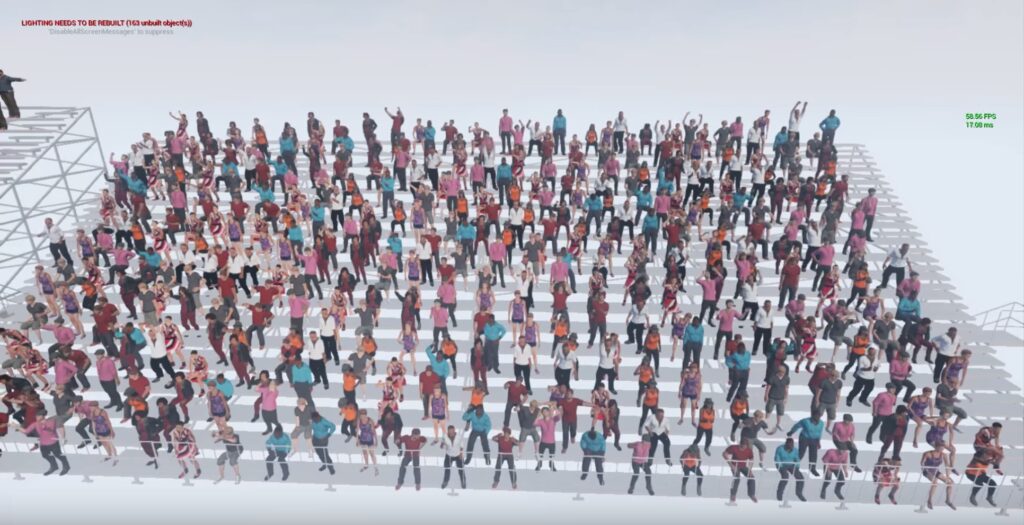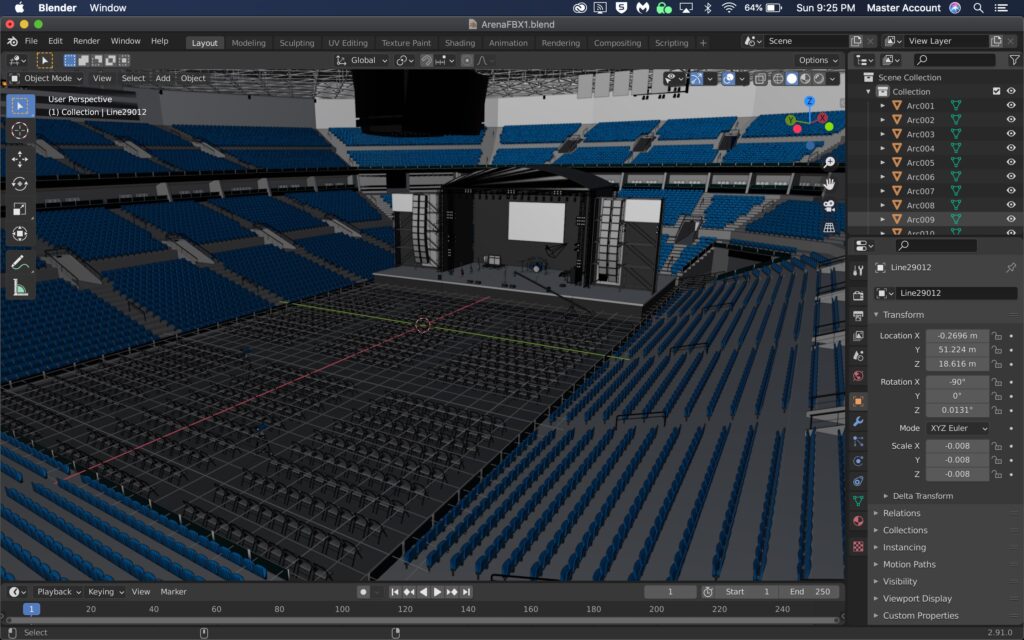June Status Report
Despite being a little behind my projected production schedule, I felt good about my final presentation in May. Everyone’s feedback was really helpful, and even though I could only provide a demo video instead of a user-testable version, it was very well-received. Notably, several comments I received about wanting to see more of the “drama in the audience” made me feel that I was on the right track in stirring up my desired emotional response from the user. People were engaged in the act of merely being in a theater among cheering spectators, and that was just from a barebones proof-of-concept prototype.
Encouraged by this, I started production on v2.0, scouting for a new, larger venue with the intention of setting up more of a concert scene, to broaden the appeal and accessibility for users who may not relate to the more formal experience of a proscenium theater. I was hoping to find something along the lines of Madison Square Garden, with the scale and energy of a large venue, but not as overwhelming as a stadium. I wanted a capacity of about 10,000 (compared to MSG’s 18,000) to simulate what I call the “intimate arena” feel I get from the Garden. All this, and it had to look realistic enough to sell the illusion.
After a substantial search, I found exactly what I was looking for: a structure with almost the exact concert layout as MSG, with floor level seating in front of a built stage, which I could change to a standing-room “general admission” layout. All that, minus the upper 200-level seating section – perfect.
Now the challenge was streamlining the process of building the crowd. The mo-cap animations I used in the prototype were great, but if scaled up to 10,000, they overwhelm the processor and you end up with major performance problems. Even if that wasn’t the issue, I’d have to find another way to populate an arena of that size, because placing animations, skinning them with human faces and clothing, and randomizing their appearance and behaviors one by one was not viable. I knew there had to be a specific solution for this: I’m not the first person to try this, and we’ve all seen films and shows with hundreds or thousands of digital “extras” in sports, battle, and crowd scenes. It took longer than planned, but eventually I found two options, plugins for Unreal called Golaem, and Atoms, respectively. “Crowd generator” software that would do exactly what I was looking for. Only one hangup: both are for Windows or Linux only.
So now I had to pivot to an entirely new platform altogether, mid-project. It wouldn’t be so bad, I thought – after all, v2.0 was basically starting all over again, and now I had a venue and the means to fill it. So, back to the venue…
I downloaded the model in several formats, and even requested a converted version specifically for Unreal. Importing models is usually dicey, and one this big was bound to pose some problems.
It did.
I imported the pre-converted Unreal file, but it was not exactly ready for prime time. All the geometry converted beautifully, but it was a few thousand spare parts with no indication of how they went together. I didn’t expect it to import fully lit, with materials and textures all rendered and ready to go – but I did expect some sort of constructed model I could begin to work with right away. Now I had a huge collection of virtual Legos with no idea of how they went together. So I tried again with the FBX file, letting my machine run overnight on a cooling pad. FBX’s seem to play nice with Unreal, and will work after conversion, which Unreal can do natively. And it did – well, kinda… same bag of Legos. The other supplied file formats (OBJ and 3ds) also required overnight import time and gave me the same result: an extensive collection of individual shapes, but nothing I could start working with right away. And I still had to see if this would all work on my newly-acquired Windows workstation, courtesy of NYU Skirball Production (thanks for saving my ass, guys).
SO…. As a Hail Mary, I tried opening the FBX file in Blender, even though it seemed like an unnecessary extra step with another program I’m just not that familiar with. More time to import and render and export back to Unreal and … well, actually – it works!
So I’m currently looking at a fully constructed 20,000 seat arena in Blender – nice. I’ll be working on getting it into my Mac install of Unreal, and see if I can share the whole thing with Unreal on the PC so I can get some bodies in there.
Thesis ++ with Anna this week helped me come to terms with the hard truth that I may have to sacrifice a substantial amount of what I want, in order to simply get what I need in order to make this work. So I’ve also started on the all-too-important sound design to try to cobble together a user-test version for this week.
Oh yeah, that… user testing. Right…
Losing three weeks of production time because I was called back to work earlier than expected was a tough pill to swallow. Obviously, there was always the potential for something to go awry, so delivering a fully-realized version of our project was never guaranteed for any of us – but I didn’t think I’d have to face the likelihood of a total failure to launch. For the first time I’m having real doubts about completing this project in time.
Related Posts
1 Comment
Leave a Reply Cancel reply
You must be logged in to post a comment.
Kat Sullivan
Adam Colestock
Helen (Chenuan) Wu
Christina Lan
Dorian Janezic
George Faya
Julia Myers
Kelsie Smith
Michael Morran
Po-Wen Shih
Liu Siyan
Fisher Yu
—
Craig Protzel
Christopher Wray
Haoqi Xia
Hayden Carey
Katherine Nicoleta Helén
Maria Maciak
Parisa Shemshaki
Sakar Pudasaini
Skyler Pierce
Steven Doughty
Yiqi Wang
—
Andrew Lazarow
Benoit Belsot
Enrique García Alcalá
Hongyi Zhang
Jay Mollica
Li Shu
Teddy (Jian) Guo
Monika Lin
Wenye Xie
Yiru Lu



I think this project would really benefit from writing down your KPIs and using those at benchmarks for a production schedule!